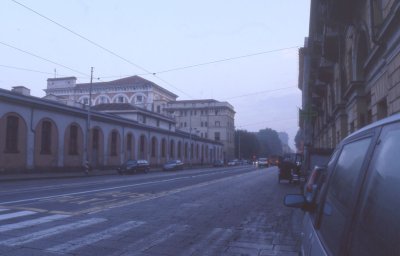 Via
Nizzza The side of the station.
Via
Nizzza The side of the station.Day One
Walked to the Salone to see how far it was.
 Via
Nizzza The side of the station.
Via
Nizzza The side of the station.
The station buildings stretched for nearly half a mile. They started with a cavernous entry hall, then there was a large shopping/service area, then there was the concourse with all of the train arrival and departure boards and then the trains. Outside there appeared to be an area for the post office and parcels after the train platforms finished.
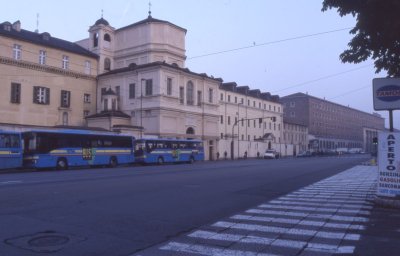 Via
Nizza .
Via
Nizza .
I think that this large building may have been a nunnery or monastry at one time. It looked very churchy and it was the place where I saw the first beggar.
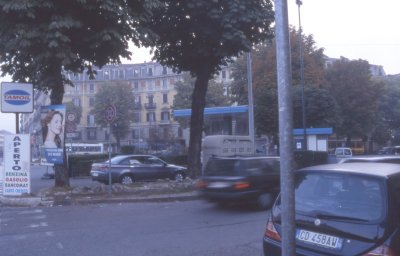 Via
Nizza – Showing tree lined road – and pissoire!
Via
Nizza – Showing tree lined road – and pissoire!
(The little grey building) You can see some of the petrol station which is little more than a layby with petrol pumps.
In the background you can see some of the older apartment buildings.

As I made my way along the road I came across a street market which amongst other things had several barrows heaped with enormous succulent vegetables. The first one that I approached expressed a reluctance to be photographed but the second fellow seemed happy enough.
Via Nizza street stall number two!
As I made my way along I came across two of these markets.
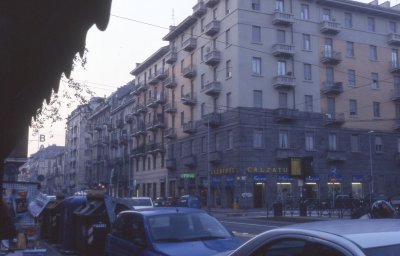
Via Nizza flats.
Further down the road there were more modern blocks of flats. This particular block has no obvious sun shades as it is facing north.
Finally after nearly an hour's walking the Lingotto came into sight. The Lingotto was originally a large Fiat car factory which has been reborn as a large exhibition and function centre. At the end closest to Turin city centre the Marriott have converted/erected a hotel.
The Lingotto appears to be in two parts the first is a very long building running alongside the road and on the roof of this building is a track for testing cars. This roadside building is joined to another large building at right angles to the road and in the 'join' between the buildings is a corkscrew concrete ramp leading to the car track on the roof. The main exhibition was held in the building at right angles to the road and the workshops were held in the first part of the roadside building.
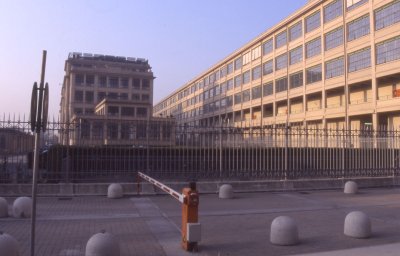 View
of the Lingotto from the entrance to the conference centre.
View
of the Lingotto from the entrance to the conference centre.
After reaching the Lingotto the next task was to find out where the buses back to the city centre ran from. A quick explore of the side roads opposite the Lingotto revealed that there was a parallel road a couple of blocks in where the buses and trams returned to the city. Thankfully there was also a convenient cafe where a cappuchino restored the spirits.
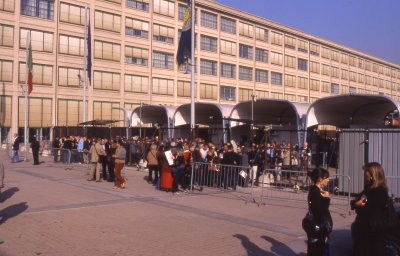 The
entry stalls to the Salone del Gusto.
The
entry stalls to the Salone del Gusto.
The sun was nearly shining now so I joined the start of the queue at 10.30 listening to the myriad languages and accents of the people around me. Near the entrance there was a Slow Food Kiosk and I went there and was given a mappa of the Salone. It was only then that I realised how vast the exhibition was. There were more than 500 stalls.
There was a space between the paying booth and the entrance and at 10.45 they started taking money and letting those that had paid proceed into this space. At 11.00 on the dot the gates were opened and the scene is depicted above with the roadside Lingotto building in the background.
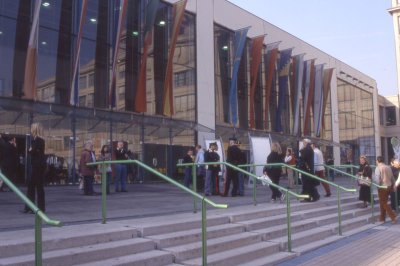
The entrance to The Salone del Gusto.
Here you see the main exhibition building which is the building at ninety degrees to the road all bedecked with flags and welcoming the early visitors. There was a healthy presence of police wherever you went and they seemed to come in different varieties. When Prince Charles came they all wore their swords. Within the exhibition you were immediately amongst the stalls.
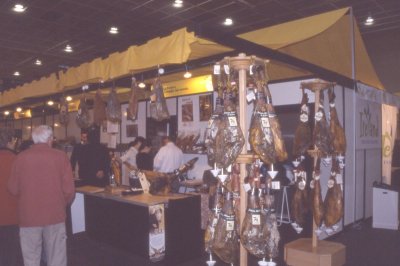
Here you see one of the first stalls near the door displaying a plethora of cured hams. I am careful about being more specific because although these may look like Parma Ham they are actually several different Spanish Hams marketed by a company called La Fenice .
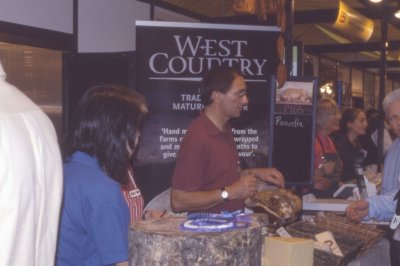
Here you see a stall by Denhay Farms they produce cheese and bacon using traditional recipes. The whole exhibition was very much – here try some. But although I looked thirsty at the Amarone stand I failed to get a glass full of that!

Some of the stalls were Praesidia, groups that are recognised by Slow Food as maintainers of endemic local products. This stall was displaying Argon Oil from Morocco. This oil is produced by processing Argon Nuts which come from the Argon tree a native tree of Morocco. The oil has a distinctive taste and is normally used as a flavouring. The product is commercially attractive and the Israelis are trying to cultivate these trees in Israel so that they may produce the oil. There follows a poor photograph of some of the Moroccan ladies in their native dress.

The Moroccan Argon Oil Ladies. They were not posers!

Parmesan Cheese. Did you know that the discriminating buyer is fussy about what year it was made!
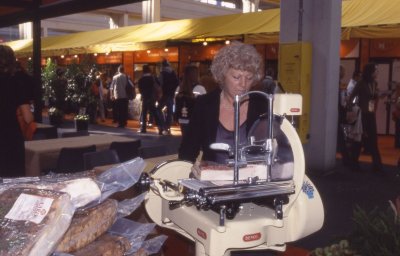
This lady is slicing what may be called streaky bacon. I would call it lard.
It is absolutely delicious thinly sliced on a piece of bread.

These are cheeses made by Castagna Selezione Formaggi in the Via del Formaggi. The alleyways with stalls on either side were named after the produce which they contained, in this case an awful lot of cheese. Cheeses of all shapes and sizes.
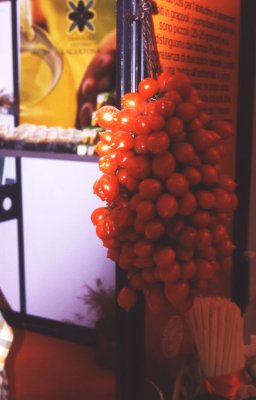
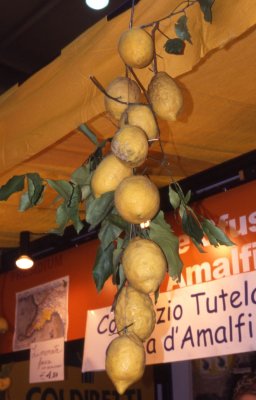
There were some vegetables on display usually extolling the virtues of various regions.
I wonder what they use to support their tomato plants!
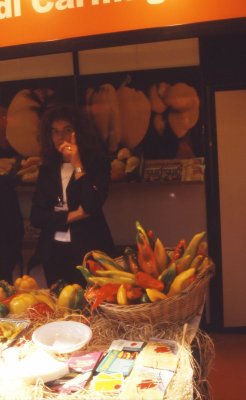
As you can see the Lemons were from Amalfi but I am afraid that I cannot recall where the peppers were from.
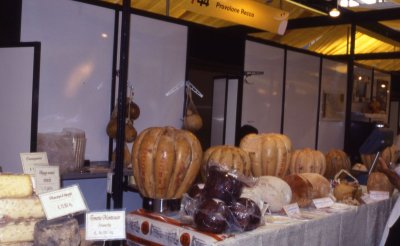
Cheeses come in many different shapes. Some of these shapes are defined by the materials available to make the cheeses with. Here I suspect that some are made in an animals stomach.
They certainly come in bizarre shapes and unusual colours.

Many of this ladies cheese are for sale and the prices range from 32 to 12 euros per kilo that equates to £18 to £7.50 per kilo.
I am not sure whether her wares were restricted to one particular area.
There were two other areas for which I have no photographs they principally exhibited rice, beans, cocoa and other grains from India, South America and North America. I cannot remember why I took no photographs but I do have some leaflets describing some of the products.
Despite all of the freebies I became peckish at lunch time and purchased a baguette and a cappuchino from one of the snack bars. Very fresh and wholesome 3.50euros £2.10!
At 4.00 I went to my first workshop. First it was necessary to register and upon presenting a letter that I had been sent I was handed an envelope with the tickets for all of the workshops that I had booked. The workshops themselves were held in quite large rooms which shared a common roof void with all of the other workshops. It was a lot of partitioned walls within the old Fiat factory and the structure of the building could be clearly seen. When entering your workshop you were issued with a radio and headphones. Channel 2 Italian, Channel 3 English. The presenters were arraigned behind two or three tables at the front of the auditorium and the 'students' were arranged behind blocks of three tables upon which there were plates, possibly pamphlets a water glass and 4 wine glasses. There must have been room for about 50 participants at each workshop and there were about 16 workshops running at a time. With three sessions each day 1pm, 4pm and 7pm.
My first workshop was entitled From San Daniele to Patadok.
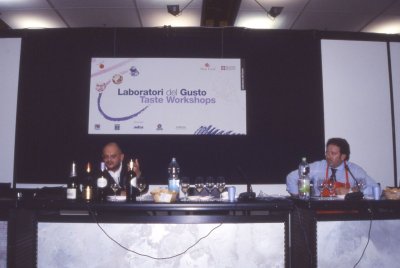 Patadok
is the name of a a number of restaurants owned by the gentleman on
the left Carlo Dall'Ava and he is responsible for the context of the
workshop.
Patadok
is the name of a a number of restaurants owned by the gentleman on
the left Carlo Dall'Ava and he is responsible for the context of the
workshop.
He cures the San Daniele ham which are aged for up to 36 months and has now branched out to purchase hams from Spain sourced from the Extremadura pig which spends a significant part of its life eating acorns.
The cured Spanish Hams are sold as Patadok hams.
Of the hams offered for tasting the original two San Daniele Italian hams were cured for 16 months, the experimental San Daniele ham and the Patadok hams were cured for 2 years. In Italy the normal stocking density of the hogs is 30 hogs/hectare but in Spain the density is down to 4 hogs/hectare. The value of the Spanish hogs is determined by the levels of oleic acid within the meat. Other than the source of the hogs the treatment of the legs is identical. The leg is removed from the carcase at the hip and any exposed meat is encased in a paste of lard herbs and spices. The ham is then hung in the curing room where a controlled fermentation and curing takes place under very close inspection. Salt and saltpetre are not applied but I suspect that they are produced during the fermentation.
During the tasting there was much sniffing, feeling of the texture and finally eating of the samples. They were very nice and the Patadok was something different – but what do you expect for 150 euros per kilo!
The tasting was lubricated by a 'Monte Rossa Bruzzo Pleno' a 'Cabochon Cabuchon', a 'Dorigo' and a Sauvignon/chardonnay. All very nice.
I met two ladies from Bath on the bus back to the city but they were only stopping for three days.